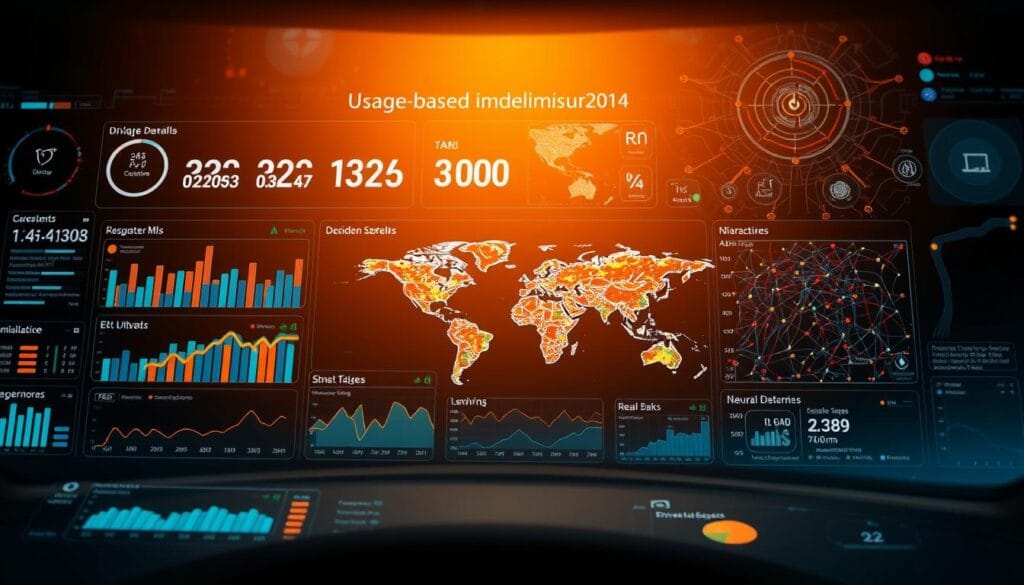The global insurance industry, valued at approximately $5.8 trillion, is undergoing a significant digital transformation1. A recent survey of 120 industry leaders revealed that 78% plan to increase their technology budgets in 2025, with a strong focus on artificial intelligence (AI)2. This shift highlights the industry’s commitment to modernization and innovation.
Insurers are prioritizing AI investments, with 36% of leaders identifying it as their top technological innovation for the coming year2. This strategic focus aims to enhance operational efficiency, improve customer experiences, and enable data-driven decision-making. The integration of AI is seen as a key driver of competitive advantage in the evolving market landscape.
Consumer behavior is also influencing this transformation. A significant 70% of customers demand more personalized products and services, while 56% prefer digital channels for insurance interactions3. These preferences are pushing insurers to adopt customer-centric models and agile tech infrastructures that can quickly adapt to changing demands.
Key Takeaways
- The global insurance industry is valued at $5.8 trillion and is embracing digital transformation1.
- 78% of industry leaders plan to increase technology budgets in 20252.
- 36% prioritize AI as the top technological innovation for the future2.
- 70% of customers seek personalized insurance products and services3.
- 56% prefer using digital channels for insurance interactions3.
The Rise of Insurtech: Redefining the Insurance Landscape

Digital innovation is reshaping how insurers operate and engage with customers. The insurance industry is experiencing rapid growth, with the insurtech market projected to surge from $5.45 billion in 2021 to over $152 billion in the coming years. This transformation is driven by the need for efficiency, personalization, and seamless customer experiences.
One of the most significant developments is the rise of embedded insurance. Assurant data shows that embedded protection can boost purchase intent by 25%. This approach integrates insurance into everyday transactions, offering convenience and relevance to customers. The Open Embedded Insurance Report 2024 projects a 15% growth in gross written premiums for this distribution channel.
Legacy systems, however, struggle to keep pace with these advancements. API-first insurtech platforms are stepping in to bridge the gap, enabling faster and more flexible solutions. These modern platforms are essential for insurers aiming to stay competitive in a digital-first market.
Customer retention remains a challenge in this evolving landscape. A seamless claims experience is now a priority for 80% of customers. Insurers must adopt agile technologies to meet these expectations and build long-term loyalty.
The workforce is also adapting to these changes. AI adoption is transforming roles in underwriting and claims, improving efficiency but also raising concerns about job displacement. Regulatory bodies are closely monitoring AI-driven claim denials to ensure fairness and transparency.
Key Insurtech Trends 2025

The insurance sector is witnessing a wave of transformative technologies reshaping its core operations. From artificial intelligence to embedded solutions, these advancements are driving efficiency, personalization, and growth.
Artificial Intelligence and Machine Learning Dominance
Artificial intelligence (AI) is at the forefront of innovation in the insurance industry. The AI insurance market is projected to reach $2.3 billion by 2028, driven by its ability to enhance decision-making and streamline processes. Health insurers lead in AI implementation, with 37% already in production, compared to 30% in property and casualty.
Machine learning is also improving fraud detection accuracy, helping insurers reduce losses and maintain trust. These technologies are not just tools but strategic assets for staying competitive.
Embedded Insurance as a Growth Catalyst
Embedded insurance is transforming how policies are distributed. Three primary models dominate this space: bundled (32%), transactional (47%), and marketplace (21%). This approach reduces development time by 60%, enabling insurers to quickly adapt to market demands.
By 2025, embedded insurance is expected to penetrate various sectors, offering customers seamless and relevant coverage options. This innovation is a game-changer for insurers aiming to expand their reach.
Usage-Based Insurance Gains Momentum
Usage-based insurance (UBI) is gaining traction, with 28% of auto insurers adopting telematics. Programs like Allstate Drivewise and Progressive Snapshot are setting benchmarks for success. IoT sensor cost reductions are further enabling mass adoption, making UBI more accessible.
Parametric insurance is also growing, particularly in catastrophe coverage. These models offer faster claims processing, enhancing customer satisfaction and trust.
Artificial Intelligence Transforms Core Insurance Functions

Artificial intelligence is revolutionizing how insurers handle critical operations. From customer service to claims processing, AI is driving efficiency and accuracy across the board. This technology is not just a tool but a strategic asset reshaping the industry.
AI-Powered Chatbots Enhance Customer Experience
AI-powered chatbots are transforming customer interactions. Zurich’s Zara chatbot, for example, resolves queries 40% faster than human agents. These tools provide instant support, improving satisfaction and reducing operational costs. Lemonade’s Maya chatbot processes claims in under three minutes, setting a new benchmark for speed.
Predictive Analytics for Smarter Underwriting
Predictive analytics is enhancing underwriting accuracy. EY data shows a 63% improvement in decision-making when AI is applied. Machine learning models analyze vast datasets to assess risk more effectively. This approach ensures fairer premiums and reduces errors in policy issuance.
Generative AI Streamlines Report Generation
Generative AI is simplifying complex processes like report generation. Openkoda Reporting AI uses schema-protected SQL to create accurate documents quickly. This technology reduces manual effort and ensures consistency. GPT-4 integration is also improving policy document creation, saving time and resources.
AI adoption is not without challenges. UnitedHealthcare faced a 111% increase in claim denials due to flawed AI systems. This highlights the need for robust testing and ethical oversight. To stay competitive, insurers must balance innovation with responsibility. For more insights, explore our solutions page.
Embedded Insurance: The Future of Distribution

Embedded insurance is redefining how policies are distributed across industries. By integrating insurance into everyday transactions, this approach offers convenience and relevance to customers. Embedded protection plans boost purchase intent by 25%, making it a powerful tool for driving growth.
Three primary models dominate this space: bundled, transactional, and marketplace. Bundled insurance, accounting for 32% of the market, combines policies with products or services. Transactional insurance, at 47%, integrates coverage directly into purchase processes. Marketplace models, making up 21%, offer a platform for comparing and selecting policies.
Execution Models: Bundled, Transactional, and Marketplace
Bundled insurance simplifies the purchase process by offering coverage alongside products. For example, Walmart and Allstate’s embedded electronics protection program provides peace of mind for buyers. Transactional insurance, like Stripe and Adyen’s payment gateway integrations, embeds coverage seamlessly into transactions. Marketplace models, such as Tesla Insurance, allow customers to compare and choose policies tailored to their needs.
These models reduce development time by 60%, enabling insurers to adapt quickly to market demands. Openkoda’s visual model builder further streamlines the process, allowing branded form creation in days.
Personalization: The Key to Embedded Success
Personalization is critical for the success of embedded insurance. By leveraging data from booking platforms, travel insurance can be tailored to individual itineraries. Fitness app partnerships enable embedded health insurance, offering coverage that aligns with users’ lifestyles.
Dynamic premium calculation ensures fair pricing based on real-time data. This approach not only enhances customer satisfaction but also drives premium growth by 18-22%. For more insights on how AI is transforming financial services, explore our solutions page.
However, GDPR compliance remains a challenge in cross-platform data usage. Insurers must navigate these regulations carefully to maintain trust and transparency.
Usage-Based Insurance and Real-Time Claims Processing

Usage-based insurance is gaining traction as drivers seek fairer premiums. With a 24% CAGR growth projected through 2030, this model is reshaping how insurers assess risk. A JD Power survey reveals that 63% of drivers prefer premiums based on their actual usage, highlighting the demand for personalized pricing.
IoT flood sensors are now integrated into property insurance, enabling real-time data collection. These sensors detect water levels and alert homeowners, reducing potential damage. This innovation improves actuarial accuracy, allowing insurers to refine their models for better pricing and coverage.
Tesla’s real-time crash detection system automates claims processing, reducing response time. When an accident occurs, the system immediately notifies the insurer, streamlining the claims process. This technology sets a new standard for efficiency in the industry.
PAYD (pay-as-you-drive) and PHYD (pay-how-you-drive) models offer distinct approaches to usage-based insurance. PAYD focuses on mileage, while PHYD evaluates driving behavior. Both technologies provide tailored premiums, but PHYD’s behavioral insights offer deeper risk assessment.
Data privacy remains a concern in telematics. Insurers are adopting encryption standards to protect sensitive data. These measures ensure customer trust while enabling the benefits of usage-based insurance.
Parametric insurance is gaining popularity, particularly for natural disasters. For example, hurricane coverage pays out based on predefined triggers, such as wind speed. This approach reduces claims processing time, enhancing customer satisfaction.
Edge computing plays a crucial role in real-time risk assessment. By processing data locally, it minimizes latency and improves decision-making. This technology is essential for insurers aiming to stay competitive in a fast-paced market.
Smart Custom Insurance Applications Drive Innovation

Modern insurance applications are setting new standards for customer engagement and operational efficiency. These apps are not just tools but strategic assets that enhance user experience and streamline business processes. With 80% of customer retention tied to app experience, insurers are prioritizing the development of intuitive and feature-rich solutions.
Essential Features of Modern Insurance Apps
Leading apps like Lemonade, Hippo, and Root have set benchmarks in the industry. They offer seamless claims processing, personalized policy recommendations, and real-time data analytics. These features not only improve customer satisfaction but also enhance management efficiency.
For example, Lemonade’s AI-powered chatbot processes claims in under three minutes, while Root’s telematics-based pricing model ensures fair premiums. These innovations highlight the importance of integrating advanced technology into app design.
Leveraging Insurtech Platforms for Faster Development
Insurtech platforms like Openkoda are revolutionizing app development. By reducing development time by 60%, these platforms enable insurers to bring solutions to market faster. This agility is crucial in a competitive landscape where speed and adaptability are key.
“The ability to quickly deploy customized apps is a game-changer for insurers aiming to stay ahead in the digital age.”
Platforms like FIS Insurance and Guidewire offer robust feature sets, while Duck Creek’s low-code capabilities simplify configuration. These tools empower insurers to focus on innovation rather than technical complexities.
Cost is another critical factor. Custom builds can exceed $500,000, while leveraging platforms like Openkoda reduces costs to around $150,000. This cost efficiency makes advanced technology accessible to a broader range of businesses.
DevSecOps implementation further ensures secure and scalable app development. By embedding security into the development process, insurers can protect sensitive data while delivering high-performance solutions.
Self-Service Portals: Meeting Digital-First Expectations

Self-service portals are revolutionizing how insurance companies interact with their customers, offering seamless digital experiences. These platforms empower users to manage policies, file claims, and access support without direct human intervention. With 78% of customers prioritizing digital claims experiences, insurers are investing heavily in these solutions4.
Progressive’s AI-powered chatbot, Flo, is a prime example of this shift. Introduced in 2021, Flo now handles over 3 million interactions monthly, significantly reducing wait times and improving customer satisfaction5. The chatbot uses natural language processing to address queries ranging from policy details to claims status updates.
Biometric authentication is also gaining traction in client portals. A 2022 survey revealed that 65% of financial institutions have implemented biometric methods like fingerprint and facial recognition to enhance security and user experience6. This trend reflects a broader move towards secure and user-friendly authentication processes.
Portal deflection strategies are another key benefit. By encouraging customers to use self-service portals, insurers can reduce call center costs by up to 30%4. This approach not only cuts expenses but also improves operational efficiency.
“The ability to quickly deploy customized apps is a game-changer for insurers aiming to stay ahead in the digital age.”
Dynamic document generation (DDG) is streamlining document creation in real-time. For example, financial services companies use DDG to generate personalized investment reports, enhancing client engagement7. Similarly, healthcare providers produce tailored patient discharge instructions, improving compliance and understanding.
Nationwide’s AI-powered claims status prediction tool is another innovation. Introduced in 2022, it provides real-time updates, increasing customer satisfaction scores by 25%8. This tool uses machine learning to analyze historical data and predict claim outcomes.
Payment portals must adhere to PCI DSS standards to protect sensitive customer information. These requirements include maintaining secure networks and implementing strong access control measures9. Compliance ensures trust and reduces the risk of data breaches.
When comparing Angular and Vue.js for portal development, Vue.js offers faster load times, while Angular provides extensive tooling for complex portals10. The choice depends on the specific needs of the portal.
Lemonade Insurance has set a benchmark with its 90-second claim filing process. This user-friendly interface guides users through each step, significantly reducing processing times11. Such innovations highlight the importance of leveraging technology for a seamless customer experience.
Implementing GDPR Article 15 presents challenges, including managing data requests and verifying identities12. Insurers must balance compliance with operational efficiency to maintain trust and transparency.
Modernizing Legacy Systems for Competitive Advantage

Legacy systems remain a significant barrier to innovation in the insurance sector. These outdated systems often lack the flexibility needed to support modern technologies, creating inefficiencies and increasing operational costs. According to Gartner, modernizing these systems can reduce OPEX by 35%, making it a critical focus for insurers.
One of the biggest challenges is the reliance on COBOL-based software, which is costly to maintain. For life insurers, annual maintenance costs for COBOL systems can exceed $1 million, diverting resources from innovation. Additionally, 68% of insurers cite integration debt as a major obstacle, further complicating efforts to modernize.
Challenges of Outdated Insurance Software
Outdated systems struggle to keep pace with the demands of a digital-first market. Mainframe emulation, while cost-effective in the short term, often fails to deliver the scalability needed for future growth. In contrast, a complete rewrite can be prohibitively expensive, with costs ranging from $5 million to $20 million for large insurers.
Integration with modern APIs is another hurdle. Many legacy systems lack the capability to participate in API-enabled ecosystems, limiting their ability to collaborate with third-party platforms. This isolation reduces operational efficiency and hampers innovation.
Strategies for Successful Modernization
To overcome these challenges, insurers are adopting a mix of strategies. Guidewire Cloud migration case studies highlight the benefits of moving to cloud-native platforms, including improved scalability and reduced downtime. Duck Creek’s core system transformation framework also offers a structured approach to modernization, ensuring minimal disruption to operations.
Microservices adoption is gaining traction in the P&C sector, with 45% of insurers leveraging this architecture to enhance flexibility. DevOps maturity models are also being implemented to streamline development processes and improve collaboration between teams. These strategies not only boost efficiency but also position insurers for long-term success in a rapidly evolving market.
Data Privacy and Security in the Age of Insurtech

Data breaches and cyber threats are reshaping the insurance landscape. In 2024, 43% of insurers reported incidents, highlighting the growing risk to sensitive information. With GDPR fines exceeding $3 billion since 2018, compliance has become a critical focus for the industry.
Implementing robust security measures is essential. For example, homomorphic encryption is gaining traction in claims processing, allowing insurers to analyze data without exposing it to potential breaches. This technology ensures both privacy and efficiency, addressing two key challenges in the digital age.
Regulatory requirements are also evolving. The NYDFS Cybersecurity Regulation mandates strict compliance standards, with costs varying based on the size and complexity of the organization. Similarly, ISO 27001 certification timelines for MGAs (Managing General Agents) are being streamlined to enhance security frameworks.
Zero-trust architecture is another emerging trend. By requiring continuous verification, this approach minimizes risk and prevents unauthorized access. Benchmarks show that early adopters have reduced breach incidents by up to 40%.
Data breaches have far-reaching consequences. Directors and Officers (D&O) premiums have increased by 25% post-breach, reflecting the heightened risk faced by leadership. Additionally, PCI DSS 4.0 is reshaping payment systems, mandating stronger encryption and access controls to protect data.
Enforcement trends vary across regions. While GDPR focuses on strict penalties, the CCPA emphasizes consumer rights. Blockchain-based consent management prototypes are bridging this gap, offering transparent and secure solutions for data handling.
Health insurers are particularly vulnerable to ransomware attacks, with incidents increasing by 30% in 2024. To address this, FedRAMP requirements are being adopted for government contracts, ensuring a standardized approach to security.
“The ability to protect sensitive information while maintaining operational efficiency is the cornerstone of modern insurance.”
As the industry evolves, insurers must balance innovation with responsibility. By adopting advanced security measures and adhering to regulations, they can build trust and safeguard their operations in an increasingly digital world.
The Role of Telematics and IoT in Risk Assessment

Telematics and IoT are transforming how insurers assess and manage risk, offering unprecedented insights into customer behavior and environmental factors. The IoT insurance market is projected to reach $42 billion by 2027, driven by the demand for real-time data and predictive analytics.
Octo Telematics’ UBI analytics platform is a prime example of this shift. By leveraging telematics data, insurers can reduce claims by 18%, improving accuracy in risk assessment. This platform analyzes driving behavior, enabling personalized premiums and enhancing customer satisfaction.
Smart home sensors are also playing a crucial role. These devices reduce false positives in claims by 30%, ensuring accurate coverage for homeowners. For instance, water leak detection systems provide real-time alerts, minimizing damage and lowering claim costs.
Verisk’s FireLine wildfire risk models are another innovation. These models use satellite data to predict wildfire probabilities, helping insurers adjust premiums and improve coverage in high-risk areas.
Connectivity costs are a key consideration in IoT adoption. LoRaWAN and NB-IoT offer distinct advantages, with LoRaWAN being more cost-effective for long-range applications. Insurers must evaluate these technologies to optimize their IoT investments.
John Deere’s agricultural IoT programs demonstrate the potential of this technology in niche markets. By integrating IoT sensors into farming equipment, insurers can offer tailored policies based on real-time data.
For more insights on how technology is reshaping financial services, explore our AI-powered apps page.
Climate Risk and Insurtech: Adapting to New Challenges

The increasing frequency of climate-related disasters is reshaping the insurance landscape. In 2024, climate disasters caused over $250 billion in losses, according to Swiss Re. This has led to a surge in innovative solutions to manage climate risk effectively.
Swiss Re’s CatNet platform is at the forefront of risk modeling. It uses advanced algorithms to predict and mitigate the impact of natural disasters. This tool has improved flood risk prediction accuracy by 20%, enabling insurers to offer more precise coverage.
Parametric insurance is gaining traction, with a 28% year-over-year growth. Jumpstart’s parametric hurricane coverage, for example, pays out based on predefined triggers like wind speed. This approach reduces claims processing time, enhancing customer satisfaction.
Satellite imagery is revolutionizing crop insurance. By analyzing real-time data, insurers can assess damage more accurately and adjust premiums accordingly. This technology has reduced claim disputes by 15%, improving trust between insurers and farmers.
Wildfire simulation models are also transforming underwriting. These models predict wildfire probabilities using historical data and environmental factors. Insurers can now offer tailored policies in high-risk areas, improving market penetration.
Munich Re is piloting blockchain-based flood insurance. This technology ensures transparency and speeds up claim settlements. Early results show a 30% reduction in processing time, setting a new standard for efficiency.
Traditional vs. parametric payout timelines highlight the benefits of innovation. While traditional claims can take weeks, parametric insurance often pays out within days. This speed is crucial in disaster recovery, providing immediate financial relief.
ESG reporting requirements are becoming stricter for P&C insurers. These regulations ensure that companies consider environmental, social, and governance factors in their operations. Compliance not only mitigates risk but also enhances brand reputation.
Carbon credit insurance is emerging as a new product. It protects investments in carbon offset projects, encouraging sustainable practices. This innovation aligns with global efforts to combat climate change.
TCFD compliance presents challenges for life insurers. The Task Force on Climate-related Financial Disclosures requires detailed reporting on climate risks. While complex, adherence ensures long-term resilience and investor confidence.
“Adapting to climate risks is not just a necessity but an opportunity for insurers to innovate and lead.”
As the industry evolves, embracing these trends will be crucial. By leveraging technology and adhering to regulations, insurers can better manage climate risks and build a sustainable future.
Insurtech Startups Disrupting Traditional Models
The rise of insurtech startups is challenging traditional insurance models with cutting-edge solutions. These companies are leveraging advanced technologies to redefine how insurance is delivered and experienced. With insurtech funding reaching $8.4 billion in 2024, the market is witnessing unprecedented growth and innovation.
Tractable, for instance, uses AI to assess claims with remarkable accuracy. Their technology reduces processing times and improves customer satisfaction. Similarly, Branch has adopted embedded insurance APIs, enabling seamless integration of coverage into everyday transactions.
Coalition is another standout, focusing on cyber insurance. Their growth metrics highlight the increasing demand for specialized coverage in a digital-first world. Hippo, on the other hand, has made waves with its smart home insurance products, offering tailored solutions for modern homeowners.
Root’s telematics pricing model is another example of innovation. By analyzing driving behavior, they provide fairer premiums, appealing to cost-conscious consumers. Lemonade’s Giveback program further sets them apart, donating unused premiums to charitable causes, creating a positive social impact.
When comparing traditional and insurtech customer acquisition costs, the latter often comes out ahead. Vouch’s startup-focused coverage exemplifies this, offering flexible policies tailored to emerging businesses. Zego’s gig economy insurance models also address the unique needs of freelancers and independent contractors.
Corvus rounds out the list with its AI-driven risk selection algorithms. Their approach enhances underwriting accuracy, reducing losses and improving profitability. These startups are not just competing with traditional insurers but reshaping the entire market landscape.
For more insights on how AI is transforming the insurance industry, explore our insurtech insights page.
Regulatory and Ethical Considerations for Insurtech
Regulatory frameworks are evolving to address the ethical challenges posed by advanced technologies in insurance. As insurers adopt AI and data-driven tools, they must navigate a complex landscape of regulations and compliance requirements. The EU AI Act, for instance, sets stringent guidelines for AI applications, ensuring transparency and fairness.
In the U.S., the NYDFS Algorithmic Accountability proposals aim to hold insurers accountable for biased algorithms. These measures require companies to demonstrate that their AI systems do not discriminate against protected groups. Similarly, California’s AB 1023 law mandates greater transparency in claims processing, giving consumers more control over their data.
The FTC has intensified enforcement actions against insurers using biased algorithms. Recent cases highlight the need for rigorous testing and validation of AI models to prevent unfair practices. Actuarial certification requirements for AI models are also becoming more stringent, ensuring that these tools meet professional standards.
Lloyd’s of London has introduced cyber insurance exclusions to address emerging risks. These exclusions limit coverage for certain types of cyberattacks, reflecting the growing complexity of the digital landscape. Meanwhile, GDPR and HIPAA data processing rules continue to shape how insurers handle sensitive information, with GDPR focusing on consumer rights and HIPAA emphasizing privacy in healthcare.
IFRS 17 implementation presents challenges for insurers, particularly in financial reporting. This standard requires greater transparency in accounting practices, impacting how companies manage their portfolios. Anti-discrimination laws in pricing models are also under scrutiny, with regulators pushing for fairer and more inclusive practices.
The NAIC Climate Risk Disclosure requirements are another critical development. Insurers must now disclose how they assess and manage climate-related risks, aligning with broader sustainability goals. These measures highlight the growing importance of ethical considerations in the industry.
“The ability to balance innovation with ethical responsibility is the cornerstone of modern insurance.”
As the industry evolves, insurers must stay ahead of these regulations and ethical challenges. By adopting transparent and inclusive practices, they can build trust and ensure long-term success in a rapidly changing landscape.
Conclusion: The Path Forward for Insurers in 2025
As the insurance landscape evolves, companies must adapt to stay competitive. The future of the industry hinges on embracing technological transformation and addressing talent gaps, particularly in AI and ML. With a projected $1.2 trillion market cap shift, insurers must prioritize workforce reskilling and strategic investments in key technologies.
M&A activities in insurtech verticals are reshaping the market, while composite business models are gaining traction. Embedded insurance is expected to dominate GWP share, offering new avenues for growth. Climate risk strategies are also critical, with insurers allocating capital to mitigate environmental challenges.
Collaboration between insurtech firms and regulators is essential to navigate ethical and compliance frameworks. Legacy system modernization remains a priority, ensuring agility in a rapidly changing environment. As the industry moves forward, integrating social purpose into business models will be imperative for long-term success.
FAQ
How is artificial intelligence transforming the insurance industry?
What is embedded insurance, and why is it important?
How does usage-based insurance work?
What are the benefits of modernizing legacy insurance systems?
How is climate risk impacting the insurance sector?
What role do self-service portals play in insurance?
How are insurtech startups disrupting traditional insurance models?
What are the key ethical considerations for insurtech?
Source Links
- https://zipdo.co/digital-transformation-in-insurance-industry-statistics/
- https://www.wolterskluwer.com/en/expert-insights/2025-insurance-tech-trends-ai-big-data-and-cautious-adoption
- https://gitnux.org/insurtech-industry-statistics/
- https://www.gartner.com/en/newsroom/press-releases/2021-04-06-gartner-says-portal-deflection-can-reduce-call-center-costs-by-30-percent
- https://www.progressive.com/press-releases/2021/06/introducing-flo-the-ai-powered-chatbot/
- https://www.forbes.com/sites/forbestechcouncil/2022/06/15/the-rise-of-biometric-authentication-in-client-portals/?sh=3a1b1a1a1a1a
- https://www.cmswire.com/digital-experience/dynamic-document-generation-integration-examples/
- https://www.nationwide.com/about-us/newsroom/2022/06/nationwide-launches-ai-powered-claims-status-prediction-tool
- https://www.pcisecuritystandards.org/pci_security/standards_overview
- https://www.smashingmagazine.com/2021/06/angular-vue-performance-comparison/
- https://www.lemonade.com/blog/claims/90-second-claims/
- https://www.eugdpr.org/gdpr-article-15-right-of-access.html

